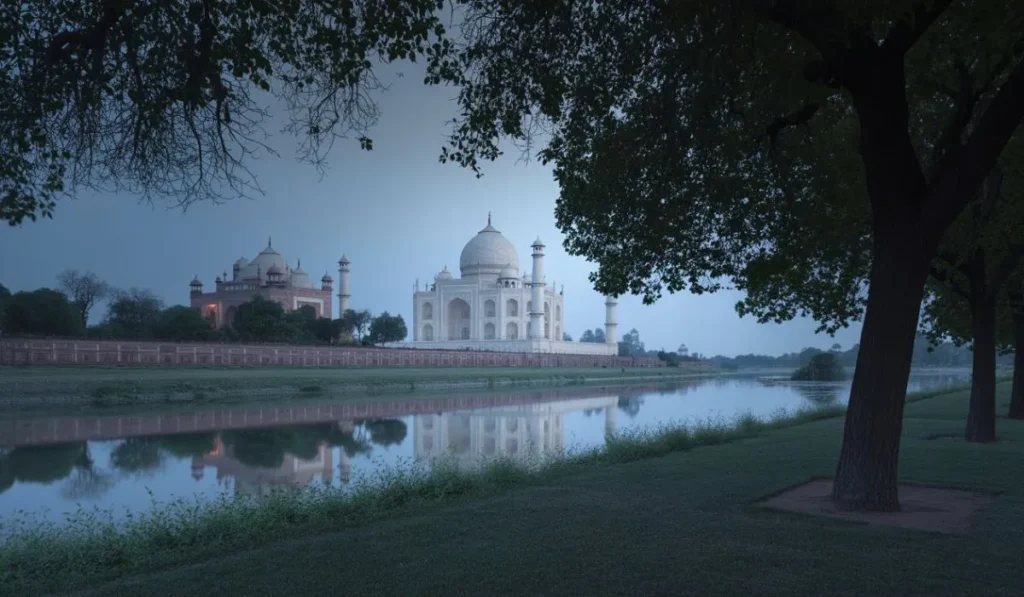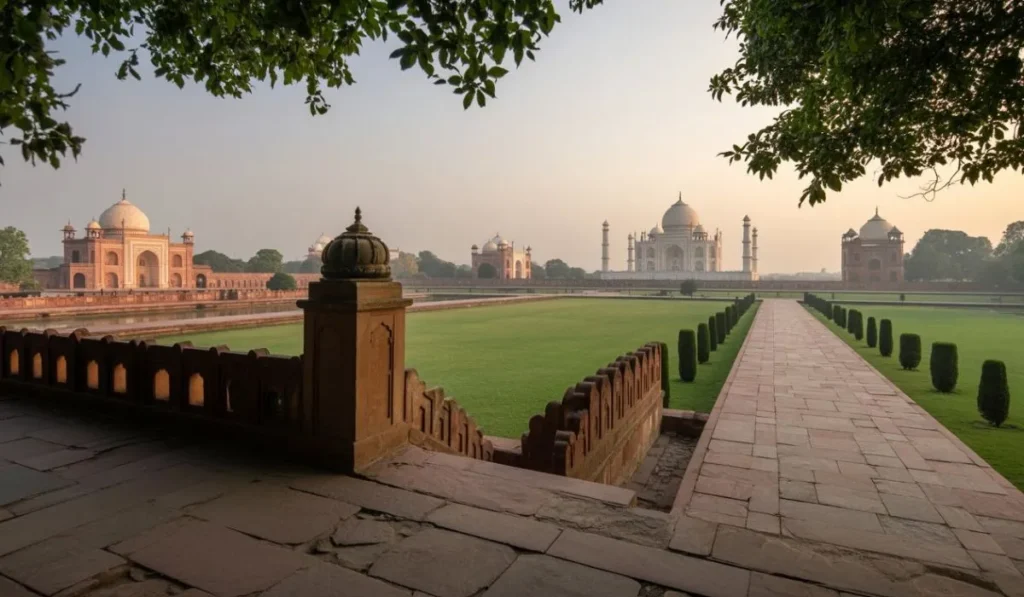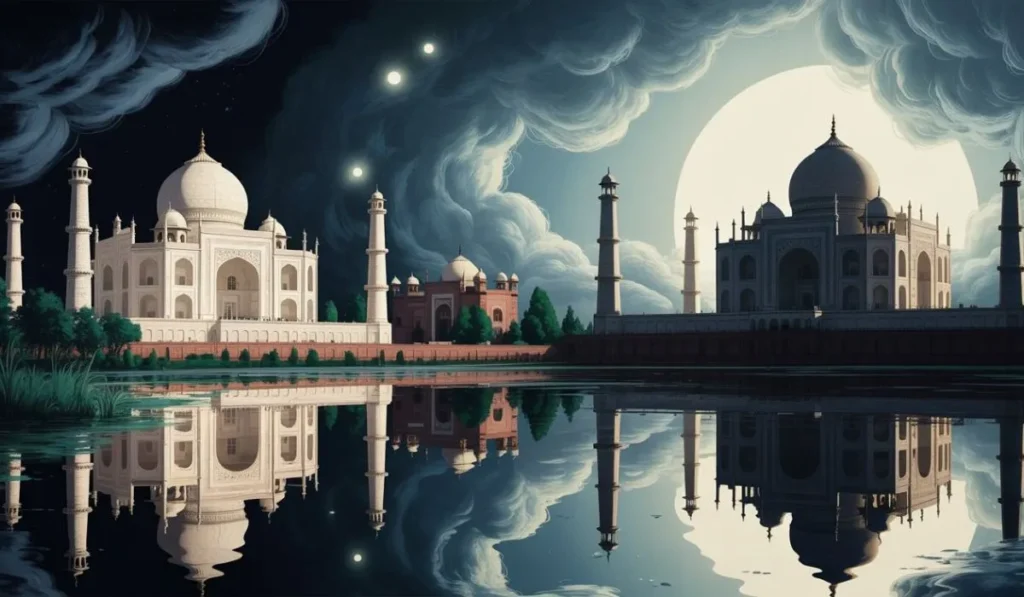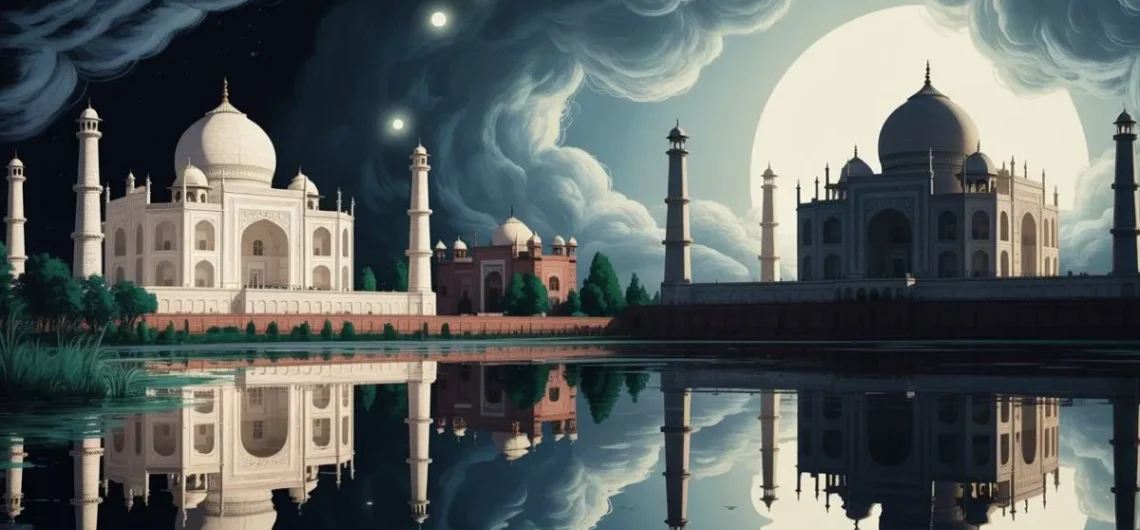
There is hardly a monument in the world that evokes as much romance and mystery as the Black Taj Mahal. This symbol of eternal love built by Mughal Emperor Shah Jahan for his beloved wife Mumtaz Mahal stands majestically on the banks of the Yamuna River in Agra, India.
Yet, behind the iconic white marble beauty lies one of the most fascinating legends in Indian history — the legend of the Black Taj Mahal. What if across the river, bathed in moonlight, there stood a twin mausoleum crafted from black marble? Does the Black Taj Mahal story have any truth or is it just a myth? Let’s embark on a journey into the Black Taj Mahal history, exploring the legend, archaeological insights, and why this tale still mesmerizes travelers today.
Shah Jahan’s Dream of a Black Marble Mausoleum
The Black Taj Mahal in India is said to have been a dark marble mausoleum planned by Emperor Shah Jahan as a symbolic counterpart to the white Taj Mahal, which he commissioned in memory of his wife Mumtaz Mahal.
According to the Black Taj Mahal story, Shah Jahan intended to build this grand structure directly opposite the Taj Mahal on the other side of the Yamuna River at a place known as Mehtab Bagh (Moonlight Garden). This monument was supposed to serve as Shah Jahan’s own tomb — constructed from shining black marble, representing mourning and eternal union with his beloved.
The earliest mention of this idea comes from Jean-Baptiste Tavernier, a French traveler who visited Agra in 1665. Tavernier’s accounts contained vivid descriptions, stating that Shah Jahan had begun the construction of a black marble mausoleum but the project was abruptly stopped when Shah Jahan’s son, Aurangzeb, overthrew him in a violent coup.
The legend says Aurangzeb, who disapproved of his father’s extravagant plans, imprisoned Shah Jahan and halted the construction. Shah Jahan spent his last years as a prisoner in the Agra Fort, gazing at the white Taj Mahal from a window, never witnessing the completion of his own black mausoleum.
Black Taj Mahal history and archaeological findings at Mehtab Bagh
The legend found curious support from archaeological excavations in the Mehtab Bagh garden, located exactly opposite the Taj Mahal. Mehtab Bagh, historically a Mughal garden built by Emperor Babur, is perfectly aligned with the Taj Mahal. In 1871, British archaeologist A.C.L. Carlleyle discovered remnants of blackened stones and what appeared to be the foundation of a significant structure.
Later excavations in the 1990s and early 2000s by the Archaeological Survey of India unearthed a large octagonal tank with fountains and garden layouts matching descriptions of the moonlight garden from Mughal records.
Some scholars initially interpreted these remnants as evidence supporting the tale of the Black Taj Mahal, believing Shah Jahan may have begun construction before his imprisonment. However, further research suggests the “black” stones found were white marble stained over time by moss, lichen, and environmental factors.
Many archaeologists emphasize that no definitive foundation or structural remains of a mausoleum were found at Mehtab Bagh. Instead, the evidence points to the site being a pleasure garden designed for viewing the Taj Mahal under moonlight.
Why the Black Taj Mahal in Agra is considered a myth by historians
Despite the romantic allure, the historical consensus among experts today is that the Black Taj Mahal in Agra never existed as a physical structure. The story is largely considered a myth or embellishment rooted in travelers’ tales and later misinterpretations.
Several reasons explain this:
- Lack of concrete archaeological evidence: Excavations at Mehtab Bagh found garden structures, but no firm evidence of a black mausoleum foundation.
- Mughal timelines: Shah Jahan had only about five years after completing the Taj Mahal before his imprisonment, insufficient to begin a second grand mausoleum.
- Aurangzeb’s role: His historical austerity and lack of records supporting the Black Taj project cast doubt on the legend.
- Reflection theory: The dark reflection of the Taj Mahal on the Yamuna River’s waters at night may have inspired the myth.
- Tavernier’s account: Seen more as a fanciful traveler’s tale than verified history.
Why the Black Taj Mahal legend still fascinates travelers today

Despite historians’ skepticism, the Black Taj Mahal story continues to captivate visitors worldwide. It adds an extra layer of mystery and romance to the Taj Mahal experience, inspiring imaginations of royal ambition, tragic family betrayal, and unfulfilled love.
A visit to Mehtab Bagh offers a rare perspective of this legend. Visitors enjoy breathtaking views of the Taj Mahal in daylight and under the moonlight from this serene garden opposite the monument. The calm waters reflecting the Taj create magical visuals fueling the Black Taj Mahal myth. Guided tours often enrich the visit with stories about the legend alongside Mughal architectural history.
How travelers can experience the mystery of the Black Taj Mahal in India
Travelers seeking to experience the mystery can easily visit Mehtab Bagh, a well-preserved garden open to the public and maintained by the Archaeological Survey of India. The garden’s fountains, walkways, and greenery provide a peaceful retreat just across the Yamuna River from the Taj Mahal.
From here, one can witness the Taj Mahal’s iconic silhouette framed perfectly by nature. Photographers and romantics flock here to capture unforgettable reflections and soak in the atmosphere of an age-old legend. Exploring both the Taj Mahal and Mehtab Bagh offers a unique blend of historical grandeur and enchanting mystery.
FAQs
Q1. What is the legend of the dark ?
The legend says Emperor Shah Jahan planned to build a black marble mausoleum opposite the Taj Mahal at Mehtab Bagh for himself, as a counterpart to the white Taj Mahal built for Mumtaz Mahal. Historians today, however, see it more as a myth than reality.
Q2. Did Shah Jahan really start building the Taj Mahal?
There are no strong archaeological proofs that construction began. Some blackened stones found at Mehtab Bagh turned out to be discolored white marble. Most experts believe Shah Jahan never started a second mausoleum.
Q3. Where was the Black Taj Mahal supposed to be built?
According to the myth, the Taj Mahal was planned on the opposite bank of the Yamuna River in Agra, at a Mughal garden known as Mehtab Bagh (Moonlight Garden).
Q4. What did Aurangzeb have to do with the Black Taj Mahal?
The story says Aurangzeb, Shah Jahan’s son, stopped the project after overthrowing his father and imprisoned him in Agra Fort. However, there are no Mughal records proving Shah Jahan had started such construction.
Q5. Is the Black Taj Mahal real or just a myth?
Historians consider it a myth because no solid evidence of a black mausoleum exists. The story is mostly based on a traveler’s account and later imaginations, though it continues to attract curiosity.
Conclusion: The romance and mystery of the Black Taj Mahal

The Black Taj Mahal is a beguiling tale intertwining love, ambition, and mythology in the heart of India’s Mughal heritage. While historians regard the story as a myth, the legend continues to evoke wonder and deepen the magic surrounding the Taj Mahal.
For travelers enchanted by romantic history, architectural marvels, and intriguing legends, visiting the Taj Mahal alongside Mehtab Bagh in Agra is a must.
Explore Taj Mahal tours in India to experience not only the iconic beauty of the white marble wonder but also the mysterious allure of the Black Taj Mahal. Step into a world where history blends with legend, and every stone whispers a timeless story of love and loss.


Comments